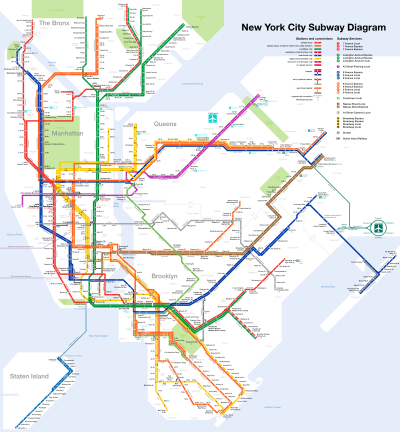
| Part of a series of articles on |
The New York City Subway is a rapid transit system that serves four of the five boroughs of New York City, New York: the Bronx, Brooklyn, Manhattan, and Queens.[a] Its operator is the New York City Transit Authority, which is itself controlled by the Metropolitan Transportation Authority of New York. In 2015, an average of 5.65 million passengers used the system daily, making it the busiest rapid transit system in the United States and the 11th busiest in the world.[1][2]
The present New York City Subway system is composed of three formerly separate systems that merged in 1940: the Interborough Rapid Transit Company (IRT), the Brooklyn–Manhattan Transit Corporation (BMT), and the Independent Subway System (IND). The privately held IRT, founded in 1902, constructed and operated the first underground railway line in New York City.[b] The opening of the first line on October 27, 1904, is commonly cited as the opening of the modern New York City Subway, although some elevated lines of the IRT and BMT that were initially incorporated into the New York City Subway system but then demolished predate this. The oldest sections of elevated lines still in operation were built in 1885. The BMT, founded in 1923 and also privately held, was formed from the bankruptcy of the Brooklyn Rapid Transit Company. The IND was created by the City of New York in 1921 to be a municipally owned competitor of the two private companies. Unification in June 1940 by the New York City Board of Transportation brought the three systems under one operator. The New York City Transit Authority, created in 1953 to be a public benefit corporation that acquired the rapid transit and surface line (buses and streetcars) infrastructure of the Board of Transportation, remains the operator of the New York City Subway today.
The official count of stations is 472; however, this tabulation classifies some transfer stations as two or more stations, which are called "station complexes" within the nomenclature of the New York City Subway. If station complexes are counted as one station each, the number of stations is 423. Thirty-two such station complexes exist. The reason for the higher count generally lies in the history of the New York City Subway: IRT, BMT and IND stations are usually counted separately, particularly if their lines are not parallel and are adjacent to or on another level to each other. Regardless of how stations are counted, the New York City Subway has the largest number of rapid transit stations in the world.
There are numerous New York City Subway stations that are closed, many of which stem from the demolition of elevated lines once operated by the IRT and the BMT that were made largely but not completely redundant to underground lines subsequently constructed.
The newest New York City Subway stations are part of the Second Avenue Subway, and are located on Second Avenue at 72nd, 86th and 96th streets. They opened on January 1, 2017.
Stations that share identical street names are disambiguated by the line name and/or the cross street each is associated with. For example, "125th Street station" can refer to four separate stations: 125th Street on the IND Eighth Avenue Line (A, B, C, and D trains), the IRT Broadway–Seventh Avenue Line (1 train), the IRT Lenox Avenue Line (2 and 3 trains), and the IRT Lexington Avenue Line (4, 5, 6, and <6> trains).[3] This situation occurs numerous times.
Cite error: There are <ref group=lower-alpha> tags or {{efn}} templates on this page, but the references will not show without a {{reflist|group=lower-alpha}} template or {{notelist}} template (see the help page).
- ^ "Annual Subway Ridership (2018–2023)". Metropolitan Transportation Authority. 2023. Retrieved April 20, 2024.
- ^ "(New York City) Subways (Facts and Figures under title of Annual Subway Ridership)". MTA.info. Retrieved April 19, 2016.
- ^ Martin, Andrew (September 9, 2004). "USA: Going underground in New York". The Daily Telegraph. Retrieved July 4, 2009.
